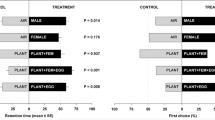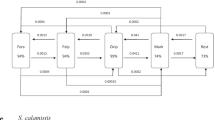Abstract
In the Republic of Benin, the scelionid egg parasitoid Telenomus isis (Polaszek) is one of the most important control factors of the noctuid maize stem borer Sesamia calamistis. In the present study, the role of various sources of contact kairomones (male or virgin or mated female moths) and of the moth's oviposition substrate (leaf sheath versus filter paper; host plant species) in host location and oviposition behavior of T. isis was investigated in Munger cells, open arenas, and/or Petri dish assays. Furthermore, its ability to distinguish between unparasitized eggs and eggs parasitized by a conspecific female or by the trichogrammatid Lathromeris ovicida was studied. In the Munger cell experiment, T. isis spent more time in moths' odor fields than in the control. There was no difference between virgin and mated females. In the open arena assay, traces left by both the male and female moths acted as contact cues, which elicited an arrestment response in the parasitoid. The residence and patch retention time in the arena with virgin or mated females of S. calamistis was about 4.8 times as long as that with males. The presence of maize leaf sheaths stimulated the oviposition behavior of T. isis when compared to eggs offered on filter paper. During the first 6 hr, more eggs were parasitized on maize leaves, although there was no difference in the final number of offspring between the two substrates. In addition, if eggs of S. calamistis were offered together with different host plant species or alone, maize and sorghum were both more attractive than millet or the egg alone and equally attractive between themselves, indicating that the plant tissue influences host finding of T. isis. Both T. isis and L. ovicida recognized markings of conspecific females, and intraspecific superparasitism was therefore low. Interspecific superparasitism was more than three times higher for L. ovicida than for T. isis, indicating that only T. isis was able to recognize the marking of the other species and tried to avoid superparasitism. Emergence of parasitoids from multiparasitized eggs generally was in favor of L. ovicida regardless of species order.
Similar content being viewed by others
REFERENCES
AGBOKA, K. 1998. Etude du comportement compétitif de Telenomus busseolaeGahan et de Telenomus isisPolaszek (Hymenoptera: Scelionidae), deux parasitoides des oeufs de Sesamia calamistisHampson (Lepidoptera: Noctuidae). Mémoire d'Ingénieur Agronome, Université du Bénin, Lomé, Togo, pp. 72.
ALDRICH, J. R., KOCHANSKY, J. P., and ABRAMS, C. B. 1984. Attractant for a beneficial insect and its parasitoids: Pheromone of the predatory spined soldier bug, Podisus maculiventris(Hemiptera: Pentatomidae). Environ. Entomol.13:1031-1036.
ALEXANDRI, M. P., and TSITSIPIS, J. A. 1990. Influence of the egg parasitoid Platytelenomus busseolae(Gahan) (Hym.: Scelionidae) on the populations of Sesamia nonagrioidesLef. (Lep.: Noctuidae) in Central Greece. Entomophaga35:16-25.
ARAKAKI, N., WAKAMURA, S., and YASUDA, T. 1996. Phoretic egg parasitoid, Telenomus euproctidis(Hymenoptera: Scelionidae), uses sex pheromone of tussock moth Euproctis taiwana(Lepidoptera: Lymantriidae) as a kairomone. J. Chem. Ecol.22:1079-1085.
BABILIS, N. A., and MAZOMENOS, B. E. 1992. Pheromone production in Sesamia nonagrioides.Diel periodicity and effect of age and mating. J. Insect Physiol.8:561-564.
BAKKER, K., VAN ALPHEN, J. J. M., VAN BATENBURG, F. H. D., VAN DER HOEVEN, N., NELL, H. W., VAN STRIEN-VAN LIEMPT, W. T. F. H., and TURLINGS, T. C. J. 1985. The function of host discrimination and superparasitization in parasitoids. Oecologia67:572-576.
BEEVERS, M., LEWIS, W. J., GROSS, H. R., JR., and NORDLUND, D. A. 1981. Kairomones and their use for management of entomophagous insects: X. Laboratory studies on manipulation of host-finding behaviour of Trichogramma pretiosumRiley with a kairomone extracted from Heliothis zea(Boddie) moth scales. J. Chem. Ecol.7:635-648.
BORGEMEISTER, C., SCHäFER, K., GEORGEN, G., AWANDE, S., SéTAMOU, M., POEHLING, H.-M., and SCHOLZ, D. 1999. Host-finding behavior of Dinoderus bifoveolatus(Coleoptera: Bostrichidae), an important pest of stored cassava: The role of plant volatiles and odors of conspecifics. Ann. Entomol. Soc. Am.92(5):766-771.
BOSQUE, C., and RABINVOICH, J. E. 1979. Population dynamics of Telenomus fairai(Hymenoptera: Scelionidae), a parasite of Chagas's disease vectors. VII. Oviposition behavior and host discrimination. Can. Entomol.3:171-180.
BOSQUE-PéREZ, N. A., and DABROWSKI, Z. T. 1989. Mass rearing of maize stem borers Sesamia calamistisand Eldana saccharinaat IITA. pp. 22-26, inTowards Insect-Resistant Maize for the Third World. Proceedings of the International Symposium on Methodologies for Developing Host Plant Resistance of Maize Insects. Centro Internacional de Mejoramiento de Maizy Trigo (CIMMYT), Texcoco, Mexico.
CHABI-OLAYE, A., SCHULTHESS, F., SHANOWER, T. G., and BOSQUE-PéREZ, N. A. 1997. Factors influencing the developmental rates and reproductive potentials of Telenomus busseolae(Gahan) (Hymenoptera: Scelionidae), an egg parasitoid of Sesamia calamistisHampson (Lepidoptera: Noctuidae). Biol. Control8:15-21.
CHABI-OLAYE, A., SCHULTHESS, F., POEHLING, H.-M., and BORGEMEISTER, C. 2000. Factors affecting the biology of Telenomus isis(Polaszek) (Hymenoptera: Scelionidae), an egg parasitoid of cereal stem borer, in Benin. Biol. ControlIn press.
COLAZZA, S., ROSI, M. C., and CLEMENTE, A. 1997. Response of the egg parasitoid Telenomus busseolae(Gahan) to sex pheromone of Sesamia nonagrioides(Lefebvre). J. Chem. Eco.23:2437-2444.
GAZIT, Y., LEWIS, W. J., and TUMLISON, J. H. 1996. Arrestment of Telenomus remus(Hymenoptera: Scelionidae) by a kairomone associated with eggs of its host, Spodoptera frugiperda(Lepidoptera: Noctuidae). Biol. Control6:283-290.
HIGUCHI, H., and SUZUKI, Y. 1996. Host handling behaviour of the egg parasitoid Telenomus triptusto the egg mass of sting bug Piezodorus hybneri. Entomol. Exp. Appli.80:475-479.
JONES, R. L., LEWIS, W. J., BEROZA, M., BIERL, B. A., and SPARKS, A. N. 1973. Host-seeking stimulants (kairomones) for the egg parasite, Trichogramma evanescens. Environ. Entomol.2:593-596.
KAISER, L., PHAM-DELEGUE, M. H., BAKCHINE, E., and MASSON, C. 1989. Olfactory responses of Trichogramma maidisPint. et Voeg.: Effect of chemical cues and behavioral plasticity. J. Insect Behav.2:701-712.
KORNOSOR, S., SERTKAYA, E., and ÖZPINAR, A. 1994. Distribution of the egg parasitoid Platytelenomus busseolae(Gahan) (Hym.: Scelionidae) and its effect on the population of Sesamia nonagrioidesLef. (Lep.: Noctuidae) in the Mediterranean region of Turkey, pp. 193-199, inE. Wajnberg (ed.). Trichogrammaand Other Egg Parasitoids. 4th International Symposium, Cairo, Egypt, October 4-7, 1994. INRA, Paris 1995. (Les Colloques, no. 73).
LEWIS, W. J., JONES, R. L., and SPARKS, A. N. 1972. A host seeking stimulant for the egg parasite Trichogramma evanescens: Its source and demonstration of its laboratory and field activity. Ann. Entomol. Soc. Am.65:1087-1089.
LEWIS, W. J., NORDLUND, D. A., GUELDNER, R. C., TEAL, P. E. A., and TUMLINSON, J. H. 1982. Kairomones and their use for management of entomophagous insects. XIII. Kairomonal activity for Trichogrammaspp. of abdominal tips, excretion, and a synthetic sex pheromone blend of Heliothis zea(Boddie) moths. J. Chem. Ecol.8:1323-1331.
MATTIACCI, L., VINSON, S. B., WILLIAMS, H. J., ALDRICH, J. R., and BIN, F. 1993. A long-range attractant kairomone for egg parasitoid Trissolcus basalis(Woll.), isolated from defensive secretion of its host, Nezara viridula. J. Chem. Ecol.19:1067-1181.
NDEMAH, N. R. 1999. Towards an integrated crop management strategy for the African stalk borer, Busseola fusca(Fuller) (Lepidoptera: Noctuidae) in maize systems in Cameroon. PhD thesis. University of Hannover, Hannover, Germany. 145 pp.
NOLDUS, L. P. J. J. 1989. Semiochemicals, foraging behavior and quality of entomophagous insects for biological control. J. Appl. Entomol.108:425-451.
NOLDUS, L. P. J. J., and NAN LENTEREN, J. C. 1985. Kairomones for the egg parasite Trichogramma evanescensWestwood. II. Effect of contact chemicals produced by two of its hosts, Pieris brassicaeL. and Pieris rapaeL. J. J. Chem. Ecol.11:793-800.
NOLDUS, L. P. J. J., LEWIS, W. J., and TUMLINSON, J. H. 1990. Beneficial arthropod behavior mediated by airborne semiochemicals. IX. Differential response of Trichogramma pretiosum, an egg parasitoid of Heliothis zea, to various olfactory cues. J. Chem. Ecol.16:3531-3544.
OKUDA, M. S., and YEARGAN, K. V. 1988. Intra and inter host discrimination in Telenomus podisiand Trissolcus euschisti(Hymenoptera: Scelionidae). Ann. Entomol. Soc. Am.81(6):1017-1020.
POLASZEK, A. 1998. African cereal stem borers; economic importance, taxonomy, natural enemies and control. CAB International in association with the ACP-EU Technical Centre for Agricultural and Rural Co-operation (CTA) 530 pp.
POLASZEK, A., UBEKU, J. A., and BOSQUE-PéREZ, N. A. 1993. Taxonomy of Telenomus busseolaespecies complex (Hymenoptera: Scelionidae) egg parasitoids of cereal stem borers (Lepidoptera: Noctuidae, Pyralidae). Bull. Entomol. Res.83:221-226.
ROSEN, D., and DEBACH, P. 1979. Species of Aphitisof the World (Hymenoptera: Aphelinidae). Dr. W. Junk, The Hague, The Netherlands.
SAS Institute. 1992. SAS User's Guide: Statistics, Version 6th ed. SAS Institute, Cary, North Carolina.
SCHOLZ, D., TCHABI, A., BORGEMEISTER, C., MARKHAM, R. H., POEHLING, H.-M., and LAWSON, A. 1997. Host-finding behaviour of Prostephanus truncatus: Primary attraction or random attack? J. App. Entomol.121:261-269.
SCHOLZ, D., TCHABI, A., MARKHAM, R. H., POEHLING, H.-M, and BORGEMEISTER, C. 1998. Factors affecting pheromone production and behavioral responses by Prostephanus truncatus(Horn) (Coleoptera: Bostrichidae). Ann. Entomol. Soc. Am.91(6):872-878.
SCHULTHESS, F., BOSQUE-PéREZ, N. A., CHABI-OLAYE, A., GOUNOU, S., NDEMAH, R., and GOERGEN, G. 1997. Exchange of natural enemies of lepidopteran cereal stem borers between African regions. Insect Sci. Appl.17(1):97-108.
SCHULTHESS, F., CHABI-OLAYE, A., and GOERGEN, G. 2000. Seasonal fluctuations of noctuid stemborer egg parasitism in southern Benin with special reference to Sesamia calamistisHampson (Lepidoptera: Noctuidae) and Telenomusspp. (Hymenoptera: Scelionidae) on maize. Biocontrol Sci. Technol.Submitted.
SéTAMOU, M., and SCHULTHESS, F. 1995. The influence of egg parasitoids belonging to Telenomus busseolae(Hymenoptera: Scelionidae) species complex on Sesamia calamistisHampson (Lepidoptera: Noctuidae) population in maize fields in southern Benin. Biocontrol Sci. Technol.5:69-81.
SHU, S., and JONES, R. L. 1989. Kinetic effects of kairomone in moth scales of the European corn borer on Trichogramma nubilaleErtle & Davis (Hymenoptera: Trichogrammatidae). J. Insect Behav.2:123-131.
STRAND, M. R., and VINSON, S. B. 1983. Host acceptance behavior of Telenomus heliothidis(Hymenoptera: Scelionidae) toward Heliothis virescens(Lepidoptera: Noctuidae). Ann. Entomol. Soc. Am.76:781-785.
TUMLINSON, J. H., TURLINGS, T. C. J., and LEWIS, W. J. 1992. The semiochemical complexes that mediate insect parasitoid foraging. Agric. Zool. Rev.5:221-252.
TURLINGS, T. C. J., LOUGHRIN, J. H., MCCALL, P. J., RöSE, U. S. R., LEWIS, W. J., and TUMLINSON, J. H. 1995. How caterpillar-damaged plants protect themselves by attacking parasitic wasps. Proc. Natl. Acad. Sci. U.S.A.92:4169-4174.
VAN ALPHEN, J. J. M., and VISSER, M. E. 1990. Superparasitism as an adaptive strategy for insect parasitoids. Annu. Rev. Entomo.35:59-79.
VAN LENTEREN, J. C. 1981. Host discrimination by parasitoids, pp. 25-79, inD. A. Nordlund, R. L. Jones, W. J. Lewis (eds.). Semiochemicals, Their Role in Pest Control, Wiley, New York.
VET, L. E. M., and DICKE, M. 1992. Ecology of infochemical use by natural enemies in tritrophic context. Annu. Rev. Entomol.37:141-172.
VET, L. E. M., WäCKERS, F. L., and DICKE, M. 1991. How to hunt for hiding hosts: the reliability-detectability problem in foraging parasitoids. Neth. J. Zool.41:202-213.
VINSON, S. B. 1976. Host selection by insect parasitoids. Annu. Rev. Entomol.21:109-133.
VISSER, M. E. 1993. Adaptive self-and conspecific superparasitism in the solitary parasitoid Leptopilina heterotoma. Behav. Ecol.4:22-28.
VISSER, M. E., VAN ALPHEN, J. J. M., and NELL, H.W. 1990. Adaptive superparasitism and patch time allocation in solitary parasitoids: the influence of the number of parasitoids depleting a patch. Behaviour114:21-36.
WäCKERS, F. L., and LEWIS, W. J. 1994. Olfactory and visual learning and their combined influence on host site location by the parasitoid Microplitis croceipes(Cresson). Biolo. Control4:105-112.
ZABORSKI, E., TEAL, P. E. A., and LAING, J. E. 1987. Kairomone-mediated host finding by spruce budworm egg parasites, Trichogramma minutum. J. Chem. Ecol.13:113-122.
Author information
Authors and Affiliations
Rights and permissions
About this article
Cite this article
Chabi-Olaye, A., Schulthess, F., Poehling, HM. et al. HOST LOCATION AND HOST DISCRIMINATION BEHAVIOR OF Telenomus isis, AN EGG PARASITOID OF THE AFRICAN CEREAL STEM BORER Sesamia calamistis. J Chem Ecol 27, 663–678 (2001). https://doi.org/10.1023/A:1010341716847
Issue Date:
DOI: https://doi.org/10.1023/A:1010341716847




